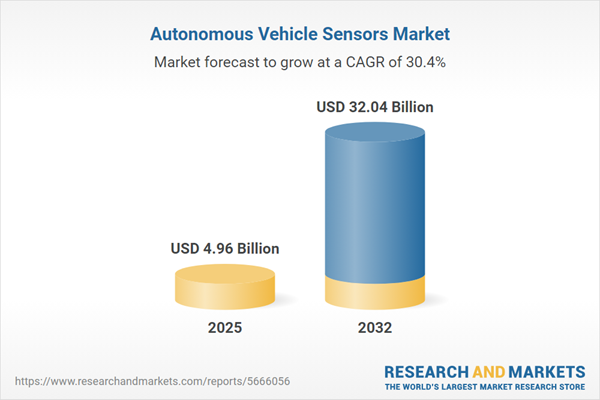Speak directly to the analyst to clarify any post sales queries you may have.
Senior executives in the autonomous vehicle sensors market are navigating a rapidly shifting landscape shaped by regulatory demands, global competition, and ongoing advances in sensor technology. Forward-thinking strategies are crucial for organizations to achieve market resilience and seize new opportunities amid persistent industry evolution.
Market Snapshot: Autonomous Vehicle Sensors
The autonomous vehicle sensors market is currently valued at USD 3.82 billion in 2024, with projections indicating a rise to USD 4.96 billion in 2025 and USD 32.04 billion by 2032. This corresponds to a compound annual growth rate (CAGR) of 30.44%. This impressive growth trajectory highlights ongoing advancements across core sensor technologies, such as LiDAR, radar, imaging systems, and ultrasonic solutions, which collectively drive improvements in vehicle perception and safety. As the market continues to develop, industry players are responding with innovative product launches, enhanced supply chain coordination, and integration of sensor systems that align with diverse safety regulations across major global regions.
Scope & Segmentation of the Autonomous Vehicle Sensors Market
This comprehensive report provides senior decision-makers with the detailed market intelligence necessary to inform investment strategies and operational planning in the autonomous vehicle sensors sector. Deep segmentation analysis offers clarity on priority markets, technology adoption, and evolving customer demands.
- Sensor Types: Includes monocular, stereo, high-definition, and multi-spectral cameras; near and far infrared devices; solid-state, flash, and mechanical LiDAR systems; multiple radar modules; and adaptive ultrasonic sensors. These components cater to a full spectrum of advanced driver assistance and autonomous navigation needs, supporting both standard and high-performance applications.
- Vehicle Types: Covers commercial vehicles—such as fleets, trucks, buses, and vans—and a broad range of passenger vehicles, including hatchbacks, sedans, and SUVs. This segmentation ensures the technology’s relevance across varying use scenarios and vehicle categories, from urban passenger transport to long-haul logistics.
- System Components: Incorporates a balanced mix of electronics, optics, mechanical assemblies, and perception software. Together, these systems deliver accurate real-time mapping, localization, and dynamic operational control. Technical consulting services further reinforce the deployment, integration, and ongoing reliability of sensor networks.
- End Users: Encompasses logistics companies, mobility service providers, government and defense entities, and enterprise clients. Each group features specific operational requirements, shaping the customization and integration criteria for sensor solutions and influencing overall adoption strategies.
- Regional Coverage: The Americas, Europe, the Middle East and Africa, and Asia-Pacific. Each region presents distinct challenges related to infrastructure maturity and regulatory frameworks, affecting strategic priorities and shaping tailored market approaches.
- Company Coverage: Highlights leading market participants, including Robert Bosch GmbH, Continental AG, Valeo SA, Aptiv PLC, Magna International Inc., DENSO Corporation, ZF Friedrichshafen AG, Velodyne Lidar, Inc., Luminar Technologies, Inc., and Innoviz Technologies Ltd. These organizations drive sector growth through technology development, investment, and strategic partnerships.
Key Takeaways: Strategic Insights for Senior Decision-Makers
- Expanding sensor product portfolios allows firms to comply with diverse operational standards and more easily adapt to changing customer and regulatory demands across global markets.
- Innovations in solid-state LiDAR and microelectromechanical systems broaden possible use cases, particularly for specialized autonomous platforms and next-generation mobility services.
- Sensor architectures that emphasize modularity and adaptability help organizations respond efficiently to shifting industry standards and evolving operational requirements.
- Collaboration among manufacturers, semiconductor suppliers, and software developers facilitates robust system integration and supports alignment with international compliance benchmarks.
- Developing standardized calibration methods and maintenance protocols is vital for ensuring consistent sensor accuracy and performance under varying environmental conditions.
- Strengthened supply chain strategies—focusing on diversification and proactive risk management—sustain operational continuity in the face of regulatory or geopolitical uncertainties.
Tariff Impact: Navigating Supply Chain Disruption
The introduction of US tariffs on electronic and optoelectronic components is compelling sensor manufacturers and their suppliers to reassess traditional sourcing and production strategies. By pivoting to modular product architecture and leveraging more agile and geographically diverse supply networks, organizations can better control costs and reduce vulnerability to import-related disruptions. These adjustments support business continuity and protect against the uncertainties created by shifting regulatory environments.
Methodology & Data Sources
This report relies on a combination of executive interviews, structured industry surveys, and careful analysis of third-party market data. Scenario-based methodologies provide focused, actionable recommendations to support executive risk management and market entry strategies in the autonomous vehicle sensors market.
Why This Report Matters
- Equips senior executives with accurate, data-driven insights needed to identify emerging growth areas and potential risks in a fast-changing sector.
- Supports strategic planning by clarifying regional technology adoption patterns, regulatory movements, and infrastructure developments influencing the market.
- Enables data-informed decisions regarding technology partnerships, investment prioritization, and resource allocation to retain a competitive edge.
Conclusion
This report empowers executive teams with actionable intelligence, supporting the anticipation of industry change and the development of resilient strategies as the autonomous vehicle sensors sector evolves.
Additional Product Information:
- Purchase of this report includes 1 year online access with quarterly updates.
- This report can be updated on request. Please contact our Customer Experience team using the Ask a Question widget on our website.
Table of Contents
3. Executive Summary
4. Market Overview
7. Cumulative Impact of Artificial Intelligence 2025
Companies Mentioned
The companies profiled in this Autonomous Vehicle Sensors market report include:- Robert Bosch GmbH
- Continental AG
- Valeo SA
- Aptiv PLC
- Magna International Inc.
- DENSO Corporation
- ZF Friedrichshafen AG
- Velodyne Lidar, Inc.
- Luminar Technologies, Inc.
- Innoviz Technologies Ltd.
Table Information
| Report Attribute | Details |
|---|---|
| No. of Pages | 190 |
| Published | October 2025 |
| Forecast Period | 2025 - 2032 |
| Estimated Market Value ( USD | $ 4.96 Billion |
| Forecasted Market Value ( USD | $ 32.04 Billion |
| Compound Annual Growth Rate | 30.4% |
| Regions Covered | Global |
| No. of Companies Mentioned | 11 |









